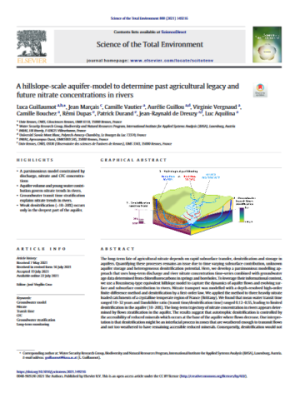
Cette étude publiée dans la revue Science of The Total Environment en octobre 2021, pilotée par Luc Aquilina, a été menée dans le cadre du second plan algues vertes et a été financée par la Région Bretagne, l’Agence de l’Eau Loire-Bretagne et l’Etat avec le soutien du Creseb. Elle a consisté d’une part à compléter les données d’observation existantes (débits, concentrations en nitrate) par la mesure du temps de résidence de l’eau dans le milieu souterrain. D’autre part, une approche parcimonieuse de modélisation tirant profit des données disponibles a été développée.
Abstract
The long-term fate of agricultural nitrate depends on rapid subsurface transfer, denitrification and storage in aquifers. Quantifying these processes remains an issue due to time varying subsurface contribution, unknown aquifer storage and heterogeneous denitrification potential. Here, we develop a parsimonious modelling approach that uses long-term discharge and river nitrate concentration time-series combined with groundwater age data determined from chlorofluorocarbons in springs and boreholes. To leverage their informational content, we use a Boussinesq-type equivalent hillslope model to capture the dynamics of aquifer flows and evolving surface and subsurface contribution to rivers. Nitrate transport was modelled with a depth-resolved high-order finite-difference method and denitrification by a first-order law. We applied the method to three heavily nitrate loaded catchments of a crystalline temperate region of France (Brittany). We found that mean water transit time ranged 10–32 years and Damköhler ratio (transit time/denitrification time) ranged 0.12–0.55, leading to limited denitrification in the aquifer (10–20%). The long-term trajectory of nitrate concentration in rivers appears determined by flows stratification in the aquifer. The results suggest that autotrophic denitrification is controlled by the accessibility of reduced minerals which occurs at the base of the aquifer where flows decrease. One interpretation is that denitrification might be an interfacial process in zones that are weathered enough to transmit flows and not too weathered to have remaining accessible reduced minerals. Consequently, denitrification would not be controlled by the total aquifer volume and related mean transit time but by the proximity of the active weathered interface with the water table. This should be confirmed by complementary studies to which the developed methodology might be further deployed.



